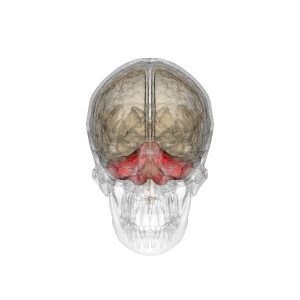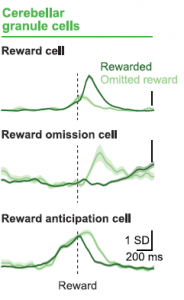Reward and the Cerebellum
| By Jon Horvitz
I’m jealous of Emma’s ability to jump with such skill. She jumps from the bed to the dresser, then down to the floor. It all appears effortless. I suspect that a human with her movement skills and graceful balance would be an Olympic gold medal winner in acrobatic gymnastics year after year. I attribute her skill to her unbelievable cat cerebellum. With her cat cerebellum and my dogged determination, I believe I would have a real shot at the Olympics.

The cerebellum ( Anatomography maintained by Life Science Databases(LSDB).Creative Commons -BY-SA-2.1-jp)
If you watch someone who has had too much alcohol struggle to keep their balance while walking, you’re observing first-hand the impairing effects of alcohol on cerebellar function. All kinds of damage to the cerebellum can impair our ability for precise and accurate movement. But the cerebellum plays a role in cognition too. In fact, it is involved in reward-related learning. When you think of reward system in the brain, you probably think dopamine, opioids, the nucleus accumbens (take a look at chapter 11: Reward, Reinforcement, and Addiction). But the cerebellum generates reward signals as well (Kostadinov and Häusser, 2022).
For instance, researchers trained thirsty mice to expect a small amount of water reward just after they heard a tone (Wagner et al 2017). But sometimes the tone came on and no reward was delivered. The “Reward cell” shown below is a cerebellar neuron that fires rapidly only when reward is delivered (the solid green line that peaks after the dotted vertical line). Other neurons, the “reward omission cells”, fire only in response to the disappointing omission of the reward. (On trials where the reward was omitted, the dotted vertical line represents the moment just after the tone when the reward would have been delivered.) Once the mice learned the task, some cells would fire in response to the tone, that is, the event that told the animal reward was likely to come (bottom, ‘reward anticipation cell’). Those are likely the same cells that become active in Emma’s cerebellum when she hears me opening a can of cat food.
The cerebellum contains several cell types, and two have been shown to generate ‘reward’ signals. One of those is the tiny cerebellar granule cells. There are a ton of them. In fact, they make up half of the total number of neurons in the entire brain. Some of the same cerebellar granule cells that respond to reward also play a key role in guiding movements.

As Emma’s cerebellum guides her graceful jumps from the bed to the dresser, some of these cerebellar cells are registering when a reward occurs. Does a successful jump, say a challenging one, count as a ‘reward’? Will it make her cerebellar granule cells fire? I imagine so. Will it activate the same cerebellar granule cells that are activated by her favorite foods? That I’m not as sure about. We’ll have to wait for more data to come in.
- Wagner, M.J., Kim, T.H., Savall, J., Schnitzer, M.J., and Luo, L. (2017). Cerebellar granule cells encode the expectation of reward. Nature 544, 96–100. https://doi.org/10.1038/nature21726.

Share this with
Facebook
Twitter
Email